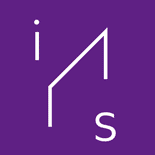今天是演示场景概论的第八节课,这一节课里我希望解答上节课结束前所提出的问题:芯片音乐场景的核心参与者为何反对将芯片音乐视为某种电子游戏的周边产品?
在上节课里,我们发现无论是温哥华这芯片音乐协会的创始人Bryan Chan还是国内最有影响力的芯片音乐家Sulumi,这些芯片音乐的社群领袖都在表达一个观点:“芯片音乐不是电子游戏音乐”。这其中最重要的一个原因,是90年代游戏行业逐渐停止使用以可编程声音发生器(PSG)为主的芯片音乐之后,芯片音乐的核心创作群体已经发生了明显的转移:由专业的游戏开发者,转向以Demoscene为中心的地下计算机爱好者社群。随着这种变化,芯片音乐社群的主流价值观也转向了“黑客伦理”,并与商业化的电子游戏企业产生了明显的分歧。
芯片音乐≠游戏音乐
芯片音乐家同时也是研究者的Anders Carlsson(GOTO80)在《芯片音乐:低技术的数据音乐共享》(Chip music: low-tech data music sharing)一文中写道
Since today’s chip music scene is essentially noncommercial, the commercial industry of video games is out of the scope of this text.
由于今天的芯片音乐场景基本上是非商业性的,电子游戏的商业产业不在本文的讨论范围之内。
这一节课我们希望解答的首要问题,既是在制作手段和表演设备上与电子游戏联系密切的芯片音乐场景是如何形成的?以及这一场景为何要强调自己在电子游戏音乐之外的独立性?
在海外的芯片音乐场景中,无论是研究者、音乐人还是社区领袖,几乎所有参与者都达成一种共识,即他们都会有意将自己在芯片音乐场景中的活动与电子游戏领域划清界线,这显然与国内以往描述芯片音乐的文章中将芯片音乐与怀旧游戏关联的描述背道而驰。
但是这是为什么?《芯片音乐:低技术的数据音乐共享》文中的一个脚注引发了我的注意,作者提及他对“场景”一次的定义来自2002年Alan O’Connor的论文《本地场景和危险的十字路口:朋克和文化混杂理论》(Local Scenes and Dangerous Crossroads: Punk and theories of Cultural Hybridity),其中提到:
When punks use the term ‘scene’ they mean the active creation of infrastructure to support punk bands and other forms of creative activity.
当朋克们使用“场景”一词时,他们的意思是积极创造基础设施来支持朋克乐队和其他形式的创造性活动。
但很显然,游戏行业并没有如上文描述的那种积极建设芯片音乐的基础设施的动作,反而CD音轨和预录制音频在游戏中的广泛运用带来的一系列行业变化,实际上压抑了芯片音乐在游戏工业中的继续发展。
游戏芯片音乐时代的结束
在去年出版的《剑桥游戏音乐指南》(The Cambridge Companion to Video Game Music,2021)中收录的《芯片音乐、所有权和数字地下》(Chiptune, Ownership and the Digital Underground)一文中引述Amiga版《银河飞将》(Wing Commander,1990)的音乐作者Mark Knight(TDK)的观点,认为CD音轨的出现让游戏音乐失去了特色:

In my opinion . . . those new formats killed computer game music. It started with the PlayStation, when instead of being stuck by limitations which forced [composers] to create music in a certain style, in a certain way and using certain instrumentations, suddenly you could go into a recording studio, you could record an orchestra or a rock band or whatever you wanted, really, and then plonk it on a CD as Red Book audio. Suddenly game music didn’t sound distinctive any more. It sounded like everything else.
在我看来……这些新格式杀死了电脑游戏音乐。这是从PlayStation开始的,当[作曲家]不再被迫受限于以某种风格、某种方式和使用某种乐器来创作音乐时,你突然可以进入录音室,你可以录制管弦乐队、摇滚乐队或任何你想要的东西,真的,然后把它作为红皮书音频放入CD。突然间,游戏音乐听起来不再有特色了。它听起来和其他东西一样。

在这篇论文中,还引述了时任DMA Designs音频主管,曾负责《百战小旅鼠》(Lemmings,1991)和《侠盗猎车手》(Grand Theft Auto,1997)等游戏音乐的Colin Anderson在接受采访时的的说法,进一步补充说明了CD音频对游戏音乐的影响。这段采访是英国阿伯泰大学(Abertay University)的《电子游戏音乐设计与开发》(Video Game Design and Development)线上课程的一部分:Interview with Colin Anderson
Probably themost significant change was the fidelity of the audio that you could create. [Sampling and CD audio] gave you access to the same resources that the film and television industries would use . . . and that meant for the first time you could use real recordings of real instruments, of real sound effects . . . instead of having to synthesise them.
最重要的变化可能是你可以创建的音频的保真度。[采样和CD音频]让你获得与电影和电视行业相同的资源……这意味着你第一次可以使用真实的乐器录音,真实的声音效果……而不是必须合成它们。
Colin Anderson在承认CD音轨带来音频保真度的提升的同时,也提及CD音轨相比声音芯片合成的音乐来说更难融入游戏的交互性:
On the downside, we lost interactivity for a while. The synth chips were particularly good because they were being coded at quite a low level. They were really good at responding to gameplay as it moved, and that went away when we started using CD and things like that . . .
在缺点方面,我们有一段时间失去了互动性。合成器芯片特别好,因为它们的代码是相当底层的。这些代码非常擅长在游戏运行的过程中作出反应,而当我们开始使用CD和类似的东西时,这一点就消失了……。
此外,Colin Anderson以《侠盗猎车手2》为例指出了CD音轨为游戏音乐带来的一个重要变化:在一些情况下,游戏公司开始与传统唱片公司合作,从唱片公司授权热门的音乐作为内置音轨。这在一定程度上削弱了游戏音乐的原创性。
For GTA 1, [all of the soundtrack material] was 100 per cent completely original material that we recorded in-house …In GTA 2 that started to change. As soon as the game became successful, suddenly people turned up wanting their favourite tracks to be licensed, and [that commercial pressure] increased [with each subsequent release].
对于《侠盗猎车手1》来说,[所有的配乐素材]都是100%完全原创的材料,全部由我们自己来制作录音……在《侠盗猎车手2》中,这种情况开始发生变化。一旦游戏获得成功,人们突然想要获得他们最喜欢的曲目的授权,而且[这种商业压力][随着每一个后续版本]增加。
我们会发现,当游戏工业中的音乐制作进入到以预录制音轨、CD音频为主要媒介的时代之后,对于游戏音乐的开发者来说,无论是制作流程,还是客户对音乐的预期都发生了显著的变化。可以说芯片音乐的游戏时代就此结束了,在此之后,演示场景几乎成了芯片音乐唯一的庇护所,而芯片音乐也逐渐走向了游戏工业的反面。《芯片音乐、所有权和数字地下》一文中这样写道:
The age of PSG video game music, then, was brought to an end as much by the commercial realities of video game production as it was by the increasing technical capacity of home consoles. However, while chiptune might have disappeared from games, reports of its demise were greatly exaggerated. Chiptune was about to develop an edge, one that would set it in direct opposition to the corporate world of professional game development.
因此,PSG电子游戏音乐的时代被视频游戏制作的商业现实以及家用游戏机日益增长的技术能力所终结。然而,虽然芯片音乐可能已经从游戏中消失了,但关于其消亡的报道被大大夸大了。芯片音乐即将发展出一种优势,这将使它与专业游戏开发的企业世界直接对立。
演示场景与芯片音乐的结合
芯片音乐与演示场景的结合很大程度上源于志愿盗版(warez)社群对芯片音乐的运用。演示场景的核心演示程序(demo)的起源即使志愿盗版社群为炫耀技术实力而制作的破解片头(cracktro)。
破解片头的容量必须足够小才能够放进软盘的引导扇区,并在加载游戏之前运行和展示动画效果,这是演示场景中Size-coding传统的根源。而这种对最小化程序容量的追求,让芯片音乐天然地成为最适合破解片头的音乐格式,在《芯片音乐、所有权和数字地下》一文中这样写道:
The code to execute cracktros had to be compact and efficient to fit in the boot sectors of floppy disks, so that the cracked game could be uploaded and downloaded easily from bulletin board services via dialup and rewritten to new floppies. The simple waveforms and sequences of PSG music, which could be stored as space-efficient single-cycle samples and tracker sequences for playback on sample-based systems, lent itself perfectly to this end. Chiptune became the sound of the digital underground.
执行破解程序的代码必须足够紧凑高效才能被装进软盘的引导扇区,这样,破解的游戏就可以通过电话线拨号从电子公告板服务(BBS)中轻松地上传和下载,并重写到新的软盘上。PSG音乐的简单波形和序列,可以被存储为空间效率很高的单周期采样和音轨,并在基于采样的系统上播放,从而完美地达成了这个目的。因此芯片音乐成为数字地下的声音。
这篇论文还提到,在志愿盗版(warez)社群中,很多时候制作精良的破解片头的影响力甚至超越被破解的游戏本身。
Over time, the competition to demonstrate both coding virtuosity and graphical and musical creativity became more important than the cracks themselves. End users would actively seek out cracked software for the cracktros, rendering the game an almost insignificant by-product of the cracking process.
随着时间的推移,展示编码能力、图形和音乐创造力的竞争变得比破解本身更重要。终端用户会主动为了获得破解片头而寻找被破解过的软件,使游戏本身成为破解过程中几乎无足轻重的副产品。
而破解片头超过游戏的吸引力最终让其脱离游戏破解活动而单独存在,这些不参与破解活动制作的“破解片头”逐渐成为一种独立的民间电脑艺术形式,即演示程序(demo),而制作这类程序的社群就是我们这个系列课程的主题:演示场景(demoscene)。
演示场景大概从90年代初开始逐渐从志愿盗版社群中分化出来,其活动聚焦于制作包含复杂视听效果的演示程序,而不再参与软件破解活动,这与游戏公司放弃使用声音芯片几乎发生在同一时期。随着演示场景对声音芯片的利用日益广泛,特别是Tracker(音轨序列器)类型的音乐制作软件的开发,演示场景无论是创作工具的丰富性还是作品的数量和质量都超越游戏行业,成为芯片音乐制作的核心群体。随着这种变化,芯片音乐社群的创作伦理和价值观也向着非商业的演示场景靠拢而明显区别于游戏行业。《芯片音乐、所有权和数字地下》指出:
The production and sharing of cracktros became an end in itself, and evolved into the demoscene, a distributed online community of digital arts practice dedicated to the production of complex real-time audiovisual displays. That combination of anti-commercialism, a distinctive sense of community and a culture of sharing marks a definite point of departure of chiptune, as a constituent part of the crackscene and demoscene, from the increasingly professionalized and corporate approach to video game music production.
制作和分享cracktros本身就成了一种目的,并演变成Demoscene,一个致力于制作复杂的实时视听展示的数字艺术实践的分布式在线社区。这种反商业主义、独特的社区意识和分享文化的结合,标志着作为破解场景和Demoscene的一个组成部分的芯片音乐,与日益专业化和企业化的视频游戏音乐制作方式的分道扬镳。It also points to a difference in mindsets. On one side sits the corporate perspective, which recognizes that there is value – and cost – in the production of professional content, be that music or software, and that it is therefore justifiable for a company to protect its investment by using a combination of digital rights management (DRM) and litigation to ensure that only legitimate copies are in circulation.
这也指出了思维方式的差异。一边是企业的观点,他们认为制作专业内容,无论是音乐还是软件,都是有价值的,也是有成本的,因此公司有理由通过使用数字版权管理(DRM)和诉讼的组合来保护其投资,确保只有合法的拷贝在流通。Set against this, the Hacker Ethic, the core philosophy of hacking culture, which originated from Massachusetts Institute of Technology in the 1950s and 1960s,18 sets out the intellectual counterpoint to this enterprise- driven process of making intellectual property out of everything, namely the ‘belief that information sharing is a powerful good and that it is an ethical duty . . . to share . . . expertise by writing free software and facilitating access to information . . . whenever possible’.
与此相对应的是黑客伦理,即黑客文化的核心理念,它起源于20世纪50年代和60年代的麻省理工学院,它提出了与这种企业驱动的将一切都变成知识产权的过程相反的思想,即“相信信息共享是一种强大的利益,通过编写自由软件和尽可能促进信息的获取来共享……专业知识是一种道德责任”。
黑客伦理是解释许多在国内难以理解,但在海外特别是欧洲普遍存在的诸多数字文化现象的关键。比如我们在第三节课详细介绍的志愿盗版(warez)社群,在90年代中期之后盗版软件在大多数国家都已经成为一件非法的事情。但人们却仍然会非盈利性地、自愿地去冒险做这样一件非法的事情。
而今天在欧洲的许多国家,以反对现有知识产权体系为主要政治主张的海盗党都非常活跃,在德国、瑞典、奥地利、捷克等国海盗党还在议会中取得了一定的席次。与之形成呼应的,是欧洲的法院也对以专利权保护软件功能持有非常谨慎的态度。
我认为我们在中国今天这样一个“知识付费”繁荣,“版权卫士”似乎占据着道德高地的背景下,必须同样注意到商业界推崇的知识产权观念并非是天然符合公众利益的,道德规范和法律法规亦不应偏袒商业领域的强者而压抑竞争和创新。欧洲繁荣的计算机地下文化及其对商业世界的挑战显然给了我们一个极好的参照系,《芯片音乐、所有权和数字地下》中指出:
History has demonstrated beyond doubt that Bill Gates and Paul Allen were right about the commercial potential of software as a commodity, but the continued growth of the underground warez scene, and the legitimate adoption of freeware, Creative Commons and open source as models for publishing and distribution suggest that attitudes around the sharing of digital content remain as strong as ever.
历史已经毫无疑问地证明,比尔·盖茨和保罗·艾伦对软件作为商品的商业潜力的看法是正确的,但地下志愿盗版社群的持续增长,以及合法化的免费软件、创作共用和开放源代码的出版和发行的模式,表明人们对分享数字内容的态度仍然像以往一样强烈。
《The Cambridge Companion to Video Game Music》第42页That anti-commercial ethos, however, and the pervasive culture of sharing, not just within the chipscene, but more broadly within the different subcultural groups that lurk beneath the increasingly corporate digital mainstream, certainly poses a challenge: as Bill Gates noted, who will create professional content – be that music or games or productivity software – if nobody is prepared to pay for it? History, however, suggests that content will still be produced both commercially and – to a very high standard – within deprofessionalized communities like the chip music scene.
然而,这种反商业化的精神和无处不在的分享文化,不仅在芯片界,而且更广泛地在潜伏在日益企业化的数字主流之下的不同亚文化群体中,当然构成了一种挑战:正如比尔·盖茨所指出的,如果没有人准备为其付费,谁会创造专业内容?——无论是音乐、游戏或生产力软件?然而,历史表明,内容仍将以商业方式生产,并同时以非常高的标准在像芯片音乐场景这样的非职业化社区中生产。
《The Cambridge Companion to Video Game Music》第49页
目前国内我们可能看到无数的产品策划案在推销“创作者经济”、“知识付费”等将创作者纳入“平台经济”的想法,这些计划几乎都预设了某种“没有付费就没有创作”的逻辑,但是我们确实能够看到,无论是开源社区、Demoscene、芯片音乐社区、乃至国内的字幕组,他们在创作大量内容的同时也都是非盈利的。
值得注意的是,并非所有的Demoscene创作都是由黑客伦理所驱动的,《芯片音乐:低技术的数据音乐共享》的作者Anders Carlsson认为青少年破解者的参与有着更简单直接地原因:
Parts of the cracker community have ideals similar to those of hackers and phreakers , but it seems likely that a lot of early crackers were kids cracking games for fun, for intellectual challenge and for ‘street credibility’.
部分破解者社区的理想与黑客和电话飞客的理想相似,但似乎很多早期的破解者都是孩子,为了好玩、为了智力挑战和“街头信誉”而破解游戏。
我认为在中国一个可以与之类比的社群是电子词典爱好者社群,当年那些躲在课桌底下为文曲星写游戏的青少年,他们的动机与西方的青少年软件破解者是极其相似的。
Tracker之前的商业电脑音乐软件
在Tracker出现之前,开发者和普通用户为电脑制作音乐的环境是截然不同的。在上节课里我们已经讲过,对于80年代的游戏开发者来说,直接修改程序代码或者使用MML(Music Marco Language)是为游戏编写音乐常用的方式,但都相当困难和耗时,这样高的门槛几乎只有受雇于游戏公司的开发者或精通编程的爱好者才有机会以这种方式编写芯片音乐。
但对于非开发者来说他们并非完全没有选择,早在80年代初,一些市售的商业软件就尝试针对普通用户提供使用家用电脑中的声音芯片编写或演奏音乐的功能。比如说1982 Commodore Music Maker就提供了一款针对Commodore 64的叠加式键盘外壳,可以将Commodore 64的电脑键盘转换为类似钢琴的黑白键音乐键盘,并提供了配套的音乐演奏和编辑软件。
【8-bit Keys】不可思议的Commodore 64音乐键盘_哔哩哔哩_bilibiliwww.bilibili.com/video/bv1xB4y187Hk
如果从音乐玩具的角度来看,Commodore Music Maker的功能基本上是合格的,它也展现出了Commodore SID芯片的一些特性,另外一个曾经被广泛使用的早期的音乐制作软件是Will Harvey’s Music Construction Set,它是艺电(EA)早期的主打产品之一,功能也较Commodore Music Maker更加丰富。
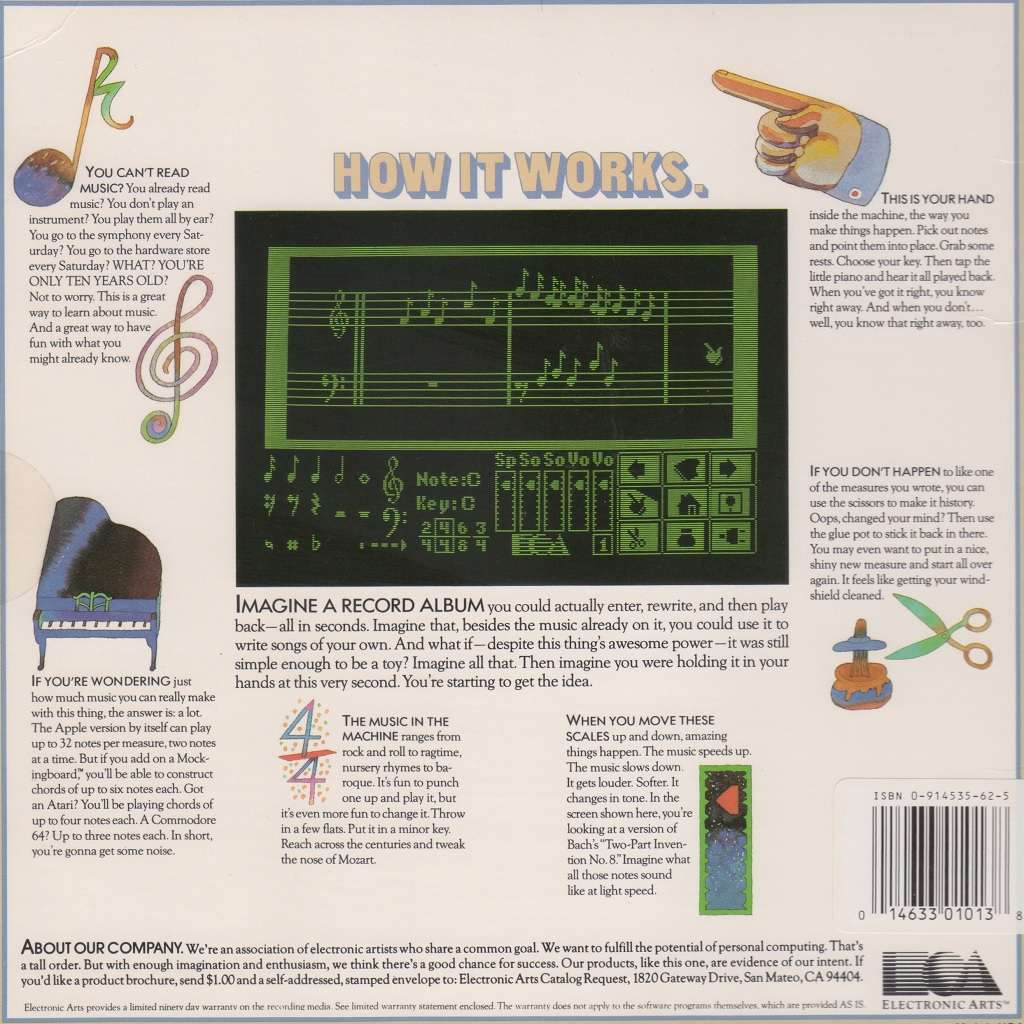
我们会发现对于针对非开发者的商业音乐软件几乎都会试图在屏幕上模仿常用的五线谱,虽然它对于有一定音乐知识的用户来说很直观,但是对于作为一种微型化合成器的声音芯片来说,这样的设计隐藏了芯片音乐的功能细节,并削弱了电子音乐中声音设计的部分。
1986:SoundMonitor
1986年,Chris Hülsbeck从简化Commodore 64上的音乐开发流程出发,开发了用于制作Commodore 64音乐的SoundMonitor,它仍然以之前十六进制代码为基础的Commodore 64音乐编辑流程为基础,但对以往基于机器码编辑器的工作流程进行了明显的改进。该软件的许多实践被后续的音轨序列器(Tracker)所继承。在墨尔本大学研究员,作曲家Kenneth B. McAlpine’s 2018年出版的《点点滴滴:芯片音乐的历史》(Bits and Pieces: A History of Chiptunes)一书中,回顾了SoundMonitor的起源和影响。
When Hülsbeck wrote Shades, he was still writing music by entering note data as hexadecimal values directly into a machine code monitor, a piece of software that allows users to view and modify the data stored in computer memory. It was a perfectly work-able approach, but only because Hülsbeck knew exactly what values to write to which memory locations. For anyone else, it was completely opaque. Hülsbeck knew that the process could be improved, and started working on a dedicated music editor. He worked throughout the summer of 1986 and submitted the result, SoundMonitor, to 64er, who published the code as their listing of the month.
当Hülsbeck编写《阴影》时,他仍然通过将音符数据作为十六进制值直接输入机器码监视器来写音乐,(机器码监视器)是一种允许用户查看和修改存储在计算机内存中的数据的软件。这是一种完全可行的方法,但前提是Hülsbeck知道该把什么值写到哪个内存位置。对于其他人来说,这完全是不透明的。Hülsbeck知道这个过程可以被改进,于是开始研究一个专门的音乐编辑器。他在1986年的整个夏天工作,并将结果SoundMonitor提交给《64er》杂志,并将代码作为他们的月度清单发布。SoundMonitor is, to all intents and purposes, a prototracker, and many of the elements that would come to typify the tracker experience can be seen in its interface. Figure 5.3 illustrates the interface: three vertically scrolling tracks, one per channel, and dedicated control commands to trigger portamento effects and arpeggiated chords. In terms of user-friendliness, it was a massive improvement over coding music directly or modi-fying data within a machine code monitor, and it provided a platform for very detailed SID programming for those musicians who understood the basics of the technology.
SoundMonitor,就其所有的意图和目的而言,是一个音轨序列器原型,可以在其界面上看到许多元素都成为后来音轨序列器软件的典型实践。图5.3展示了它的界面:三个垂直滚动的轨道,每个通道一个,还有专门的控制命令来触发滑音效果和琶音和弦。就用户友好性而言,它比直接为音乐编码或在机器码监视器中修改数据有了巨大的改进,而且它为那些了解技术基础的音乐家提供了一个非常详细的SID编程平台。
《Bits and Pieces: A History of Chiptunes》(第131页)
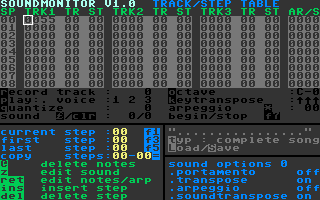
因为SoundMonitor在是以十六进制机器代码的形式直接印刷在《64er》杂志的内文中的,并没有做任何防逆向的加密,因此SoundMonitor不仅被用来为Commodore 64开发音乐程序,它本身也被二次改编,被许多开发者用作演示程序的一部分。
Commodore 64爱好者场景中对逆向、改编既有作品和开发工具的广泛接纳,与一般音乐场景里非常在意原创性,甚至为几个小节的相似而对簿公堂的做法截然不同。在《点点滴滴:芯片音乐的历史》文中以德国音乐家Thomas Detert和X-Ample演示团队的合作为例介绍了他们是如何改良和使用SoundMonitor并融入自己的作品的。
SoundMonitor provided an avenue into C64 music for many musicians and a platform for development for other coders, particularly in Hülsbeck’s native Germany. Thomas Detert, a noted C64 video game composer in his own right, started using SoundMonitor soon after, scoring demos for the Omega 8 group. But the more he tried to push it, the more he found that the CPU load needed by the driver routine was just too great; the music he was writing in SoundMonitor was pulling resources that the group needed for the graphics routines.
SoundMonitor为许多音乐家提供了进入C64音乐的途径,也为其他编程人员提供了开发平台,特别是在Hülsbeck的家乡德国。Thomas Detert,一个著名的C64视频游戏作曲家,很快就开始使用SoundMonitor为Omega 8演示小组制作曲谱。但是,他越是试图推进,越是发现驱动流程所需的CPU负载太大;他在SoundMonitor中编写的音乐占用了小组需要的图形程序的资源。To improve things, Detert turned to his friends at X-Ample Architectures, another German demo group. Together, they combined the core of SoundMonitor with a new driver written by Markus Schneider and a front-end interface by Joachim Fraeder to create the X-Ample Music Player…
为了改善情况,Detert求助于他在X-Ample Architectures的朋友,另一个德国演示小组。他们一起将SoundMonitor的核心与Markus Schneider编写的新驱动程序和Joachim Fraeder编写的前端界面结合起来,创建了X-Ample音乐播放器……This approach, of developing bespoke routines by hacking and adapting the work of others, was fairly commonplace and perhaps goes some way to explain the coherence of the C64 sound..Schneider notes that ‘90% of the music players were based on Rob Hubbard’s techniques…. Most people just optimized it and invented more tricks’.
这种通过破解和改编他人的工作来开发定制程序的方法是相当普遍的,也许可以在一定程度上解释C64声音的一致性。Schneider指出,”90%的音乐播放器是基于Rob Hubbard的技术….。大多数人只是对它进行了优化并发明了更多的技巧”。
《Bits and Pieces: A History of Chiptunes》(第132页)
采样:现代意义上的Tracker
1985年问世的Amiga电脑是现代意义上的第一款多媒体电脑,它的音、视频功能都远远领先于同时代的其他竞争对手,其中最为强大的功能之一就是Amiga电脑的音频系统可以同时播放四个通道的PCM音频采样。
1987年推出的Amiga 500价格更加便宜,推出时的售价仅售699美元或499英镑,这让它在欧洲颇为流行,Amiga电脑的标准配置带有音频输出接口,但不具备音频采样和录制功能。为了更好的利用Amiga电脑的音频功能,一系列专门为Amiga电脑设计的音频采样外设被开发出来,它们通常是连接在Amiga电脑打印机接口上的小盒子,可以将外部输入的模拟音频信号转换为可以在软件中处理的数字音频信号。在1980年代末,一套由Amiga电脑和采样扩展卡为核心的家庭录音设备花费不超过1000英镑。
Github上的开源项目Open Amiga Sampler介绍了如何用今天的物料自制一个Amiga采样器:
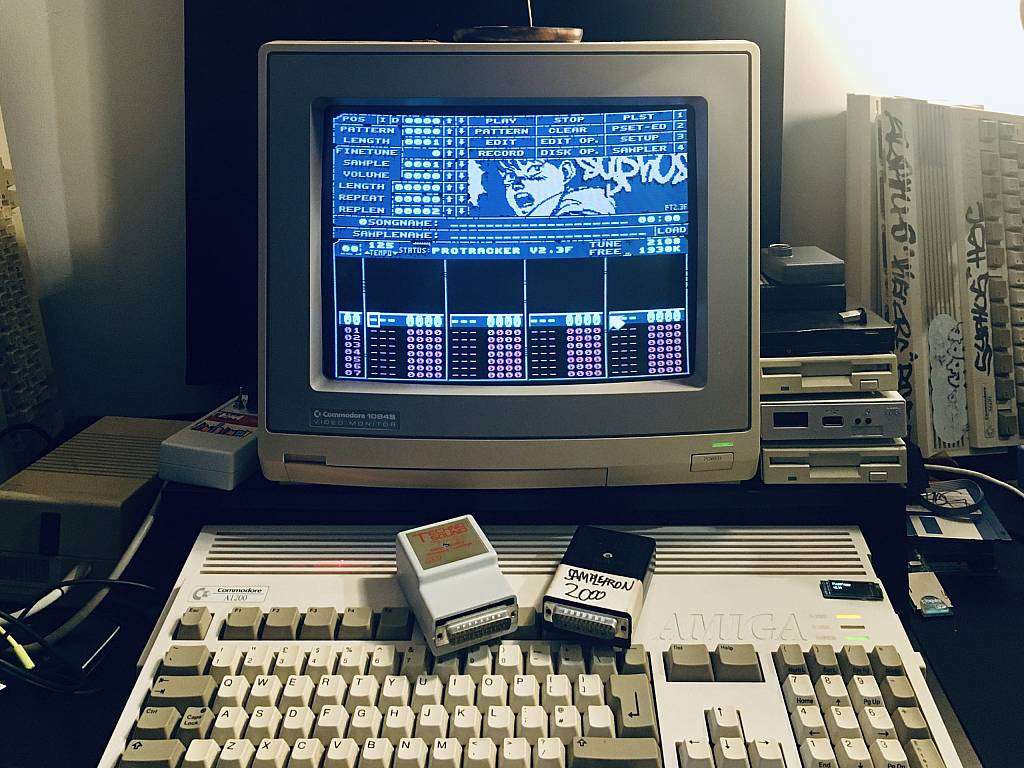
Amiga电脑和采样功能的结合极大地拓宽了80年代末业余电脑音乐爱好者可以使用的素材,爱好者可以从常见的家用录音媒介,比如盒式磁带、黑胶唱片以及无线电广播中获取音乐素材并进行采样拼贴创作。而在以往这往往需要使用昂贵的录音室设备,比如售价数万美元的Fairlight CMI才能完成。
第一批登陆Amiga平台的音乐制作软件仍然是记谱式的,这其中包括了Will Harvey’s Music Construction Set移植到Amiga电脑的版本Deluxe Music Construction Set,以及Aegis Sonix等。同一时期也出现了一些更有创意的音乐制作软件,比如以横向卷轴方式呈现音乐轮廓,并以算法自动搭配和弦的EA Instant Music。
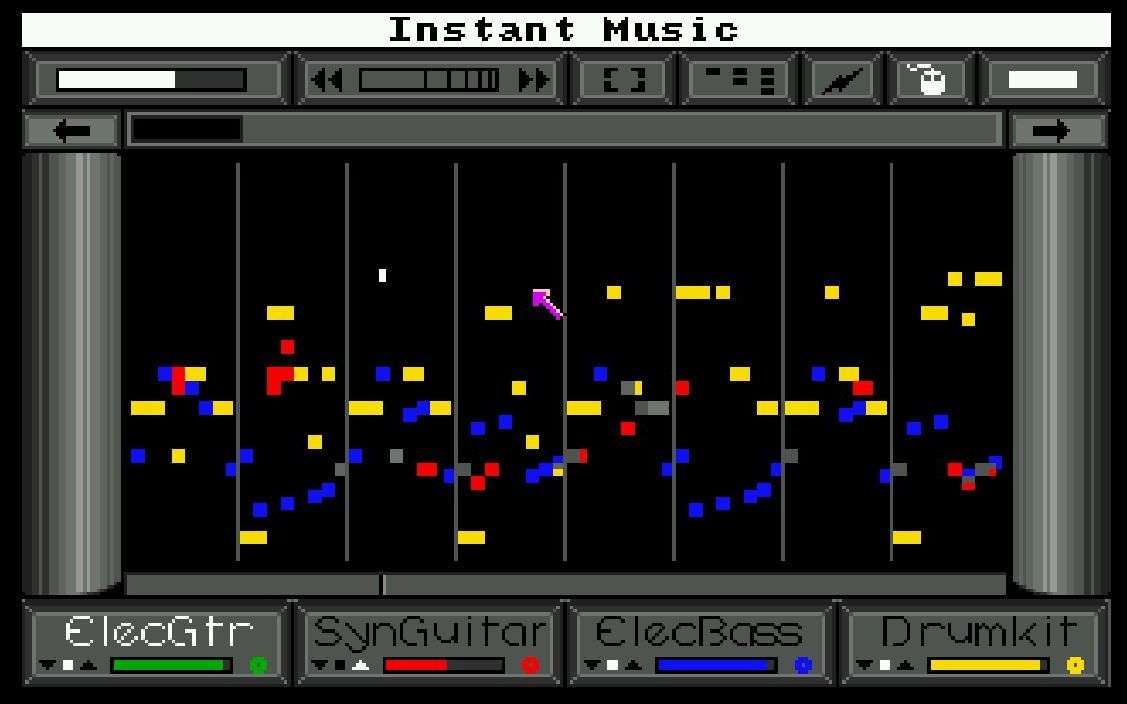
1987年,Karsten Obarski开发了名为Ultimate Soundtracker的音乐制作软件,结合了Amiga电脑的采样能力和SoundMonitor的垂直卷轴界面,并对SoundMonitor的操作进行了更适合音乐制作的改良。
And then, in 1987, Karsten Obarski, a programmer and musician with the German software house EAS, was asked by his friend, Guido Bartels, to produce a C64-style soundtrack for an Arkanoid-style game he was developing. Obarski had bought him self an Amiga 1000 a few weeks earlier and had already written some simple sample-triggering music routines. He had also worked with Chris Hülsbeck’s SoundMonitor on the C64 and liked its vertical, column-based layout. As figure 5.6 shows, his Ultimate Soundtracker combined the two.
然后,在1987年德国软件公司EAS的程序员和音乐家 Karsten Obarski,被他的朋友Guido Bartels要求为他正在开发的打砖块风格的游戏制作一个C64风格的原声带。几周前,奥巴尔斯基给他自己买了一台Amiga 1000,并且已经写了一些简单的采样触发音乐程序。他也曾在C64上使用过Chris Hülsbeck的SoundMonitor,并喜欢它的垂直列式布局。如图5.6所示,他的Ultimate Soundtracker结合了这两者。Obarski simplified the interface of SoundMonitor, losing some of the complexity of the C64 program by bringing all four of the Amiga’s four channels together into a single editable 64-step grid called a pattern. Each pattern displays the four channels as vertically scrolling columns of cells, headed Melody, Accompany, Bass, and Percussions, with a horizontal time bar that stretches across all four tracks to show the current play position. These patterns give a simple overview of the order and structure of the music, something like a musical spreadsheet, and can be sequenced and arranged in different ways to produce a song.
Obarski简化了SoundMonitor的界面,删减了C64程序的一些复杂性,将Amiga的四个通道集中到一个可编辑的64步网格中,称为样本(pattern)。每个样本都以垂直滚动的单元格列的形式显示四个通道,标题是旋律、伴奏、低音和打击乐,有一个水平的时间条,延伸到所有四个轨道,显示当前的播放位置。这些样本对音乐的顺序和结构有一个简单的概述,就像一个音乐电子表格,可以用不同的方式进行排序和安排,以产生一首歌曲。
《Bits and Pieces: A History of Chiptunes》(第138页)

在一定程度上,Tracker的界面和操作模式甚至比记谱式的音乐编辑软件更加容易,特别是对于那些没有五线谱等传统乐理知识的用户来说,他们可以像鼓机一样使用Tracker。
This no-nonsense interface removed graphical metaphors altogether, instead focusing on a concise textual representation that gave a complete overview of the musical ‘source code’. That move made it fairly straightforward to learn the screen layout and simplified the process of reading and editing music for those who weren’t fluent in traditional score notation. The software’s simplified layout and the keystroke interface turned the process of composition into something that more closely resembled musical touch-typing.
这种直接了当的界面完全取消了图形隐喻,而是专注于通过简明的文字表述,将音乐“源代码”完整概况展示出来。此举使学习屏幕布局变得相当简单,并为那些不精通传统记谱法的人简化了阅读和编辑音乐的过程。该软件的简化布局和按键界面将作曲的过程变成了更接近于音乐触摸打字的过程。
《Bits and Pieces: A History of Chiptunes》(第139页)Also, you’ve got the best elements of a drum machine, where you can string patterns together, and you can see the position of the drums and things relative to each other in time, and then you can fit your melody around that. So it’s kind of like all of the advantages of a drum machine with the advantages of something like a classical notation. It also relates very closely to the hardware, so you know there’s really nothing separating you from your instrument and you feel you’re really getting the best out of it as well.
同时,你也得到了鼓机的最佳元素,你可以把样本串起来,你可以看到鼓和其他东西在时间上的相对位置,然后你可以围绕着它来调整你的旋律。因此,它有点像鼓机的所有优点和古典记谱法的优点。它与硬件的关系也非常密切,所以你知道你和你的乐器之间真的没有什么隔阂,你会觉得你真的得到了它(鼓机功能)最好的部分。
《Bits and Pieces: A History of Chiptunes》(第140页)
MOD格式及MOD场景
Ultimate Soundtracker是第一个使用采样音轨序列模式的音乐制作软件,也是“Tracker”这一名称的起源。Karsten Obarski为它所设计的文件格式“MOD”被之后的一系列Tracker软件所兼容。实际上,包括StarTrekker、DOC Soundtracker、NoiseTracker、ProTracker等软件都是在对Ultimate Soundtracker的逆向工程的基础上完成的,这些软件修正了原始版本的Ultimate Soundtracker的一些错误,改进了程序的稳定性,并提供额外的功能。Amiga游戏资料网站ExoticA的条目记录了Ultimate Soundtracker的各个改编版本详情:Soundtracker History
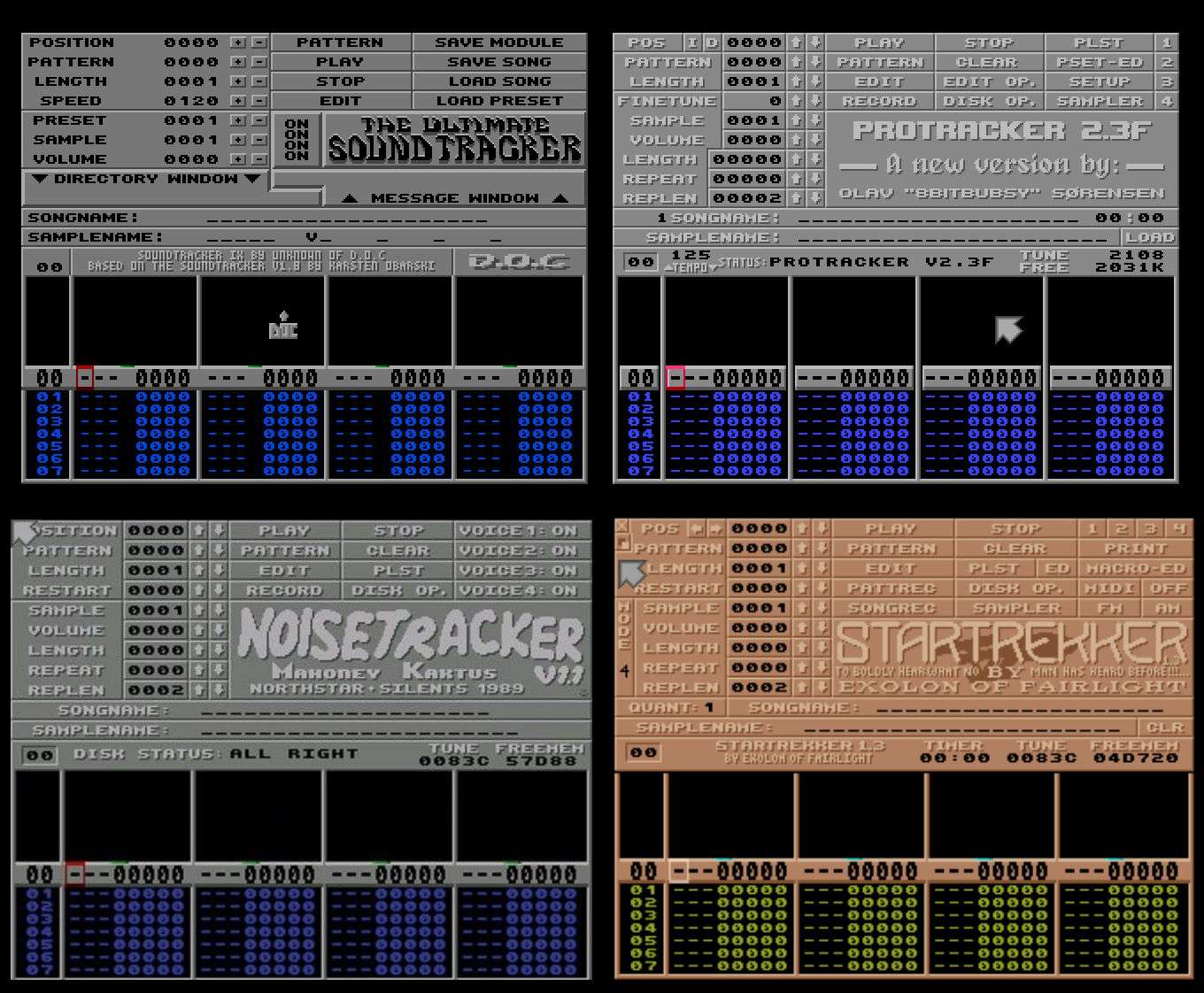
在这一过程中Karsten Obarski的著作权被破解场景所无视,作为商业软件销售的Ultimate Soundtracker也并没有取得广泛的成功。但SoundTracker的制作流程却在这一过程中被Demoscene广泛采用,MOD格式也成为Amiga电脑上采样序列音乐格式的事实标准。许多时候“MOD音乐”也被用作利用Tracker软件制作的,基于采样的音乐文件的统称。
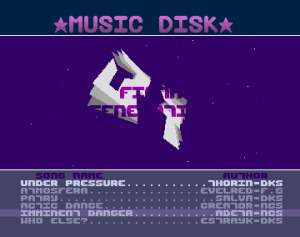
相比高度依赖硬件特性的PSG音乐,基于采样的Tracker音乐在保持足够小的文件体积的同时,在不同设备上也可以保持相对一致的播放效果。在90年代初MP3音乐流行之前,Tracker/MOD音乐也是FidoNet、Usenet和互联网上最活跃的音乐分享社群,并形成了以磁盘为单位的“音乐专辑”:只包含音乐的磁盘被称作“音乐磁盘”(music disk);而包含音乐、图像和程序混合内容的磁盘被称作“打包磁盘”(pack disk)。这种围绕着Tracker音乐制作和传播而形成的社群也被称作“MOD场景”(mod scene)。
In the days before the ubiquity of the Internet, file sharing was nowhere near as straightforward as it is now. Music files were often shared on indi¬vidual bulletin board systems (BBSs), remote computer servers that hosted software and services. By the mid-1980s, Fidonet, a global network that connects together different BBSs, had begun to emerge, making it a little easier to post and swap MODs.”
在互联网普及之前的日子里,文件共享远没有现在这么简单。音乐文件通常是在独立的公告板系统(BBS)上共享,这些远程计算机服务器承载着软件和服务。到80年代中期,Fidonet,一个连接不同BBS的全球网络开始出现,使张贴和交换MOD变得更加容易。That online sharing took place mainly in North America and western Europe, and from it emerged an active community of practitioners—not just musicians but coders and graphics artists—who developed custom fonts and graphics for musicdisks and packdisks, packaged distributable collections of music that were like digital concept albums.
这种在线分享主要发生在北美和西欧,从中出现了一个活跃的从业者社区——不仅仅是音乐家,还有程序员和图像艺术家——他们为musicdisk和packdisk开发定制的字体和图形,打包的可分发的音乐选集,就像是数字概念专辑。
《Bits and Pieces: A History of Chiptunes》(第144页)
1990年代之后,数字音频回放和录音成为PC声卡的基本功能,Tracker/MOD音乐也广泛出现在IBM PC兼容机上。特别是与演示场景联系密切的warez场景时常将Tracker音乐数据嵌入到注册机(Keygen)中,因此在北美和西欧之外演示场景存在感较弱的地方,Tracker往往也被称为“注册机音乐”(Keygen Music)。
为什么不是MIDI?
在国内,由于对演示场景和MOD场景的陌生,许多时候Tracker音乐被错误的描述为“MIDI音乐”。这在关于“注册机音乐”的文本里非常普遍。但在海外,关于芯片音乐及Demoscene的讨论中,MIDI的存在感要弱得多。
其中一个重要的原因是MIDI使用的成本比Tracker要高得多。虽然内置MIDI接口而且价格更低的Atari ST电脑在1985年几乎与Amiga同时推出,但Atari ST电脑内置的音频能力却弱得多。最初版本的Atari ST仅内置了Yamaha YM2149声音芯片,即AY-3-8910授权雅马哈生产的版本,与Amstrad CPC、MSX等八位电脑基本相同。
而要想完全发挥Atari ST内置的MIDI接口的作用,就必须配合支持MIDI接口的合成器和多轨录音机等设备一同使用,而这显然会增加不少使用成本,而支持MIDI的采样设备则更加昂贵,在1980年代末,小型录音工作室可以承受的Akai S900采样器的售价是1699英镑,约合今天的5300英镑,对于普通家庭来说仍然是相当昂贵的。
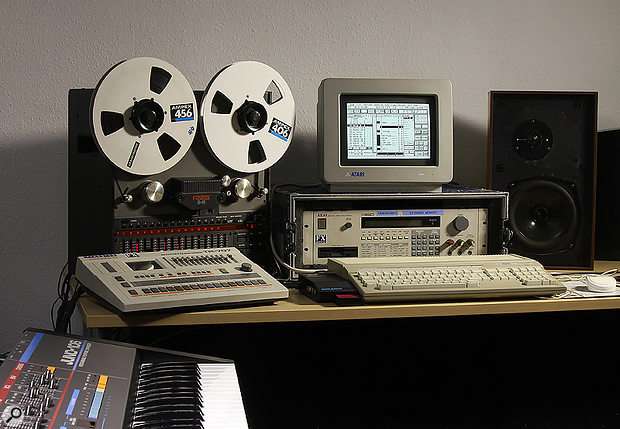
英国音乐科技杂志《Sound on Sound》在2015年曾经尝试重建1980年代的小型录音室:Recreating The ’80s Home Studio Experience
另一个限制了MIDI在演示场景和芯片音乐社群中流行的原因则是作为为录音行业设计的标准,80年代末、90年代初的MIDI难以利用有限的预算兼顾创作的灵活性和广泛的兼容性。
对于录音室来说,MIDI协议作为合成器、采样器和电脑间的通信协议,可以通过串联大量不同设备来产生各种不同的音响效果,而且几乎不用考虑产生数据在不同环境下的兼容性。80年代不同厂牌的MIDI设备的数据格式并不兼容,当使用不同品牌的音源时,同样的MIDI数据产生的声音却可能南辕北辙。
1991年的General MIDI和Standard MIDI File等标准试图将MIDI标准化,规定了128种基本乐器。但这明显地限制了创作的灵活性,特别是无法包含Tracker音乐中常见的的人声和自然环境声音采样。同时PC声卡厂商也甚少严格地实现General MIDI标准,大部分声卡都以内置的FM合成芯片模仿该标准中的乐器音色,对于追求展现技术实力的演示场景的参与者来说显然不如直接针对PC声卡所使用的OPL2/OPL3 FM合成芯片制作音乐来得直接。
总结
可以说,基于PSG的游戏音乐和基于Tracker的演示场景音乐是“芯片音乐”的两大源流,而“芯片音乐”(chiptune)也起源于演示场景用于描述那些模仿PSG声音的作品:
As more and more of these sound chip-style musicdisks were circulated, MOD fans found themselves in need of a term to differentiate them from other forms of tracked music. The Amiga, of course, could sound like a PSG, but it could also sound like a rock band or an orchestra. By 1990, chip had started to appear as a stylistic designator in MOD filenames, and in 1991 the term chiptune, meaning a piece of chip music, appeared as a title on Nuke’s mod.chiptune-12k on an Anarchy packdisk.
随着越来越多的声音芯片风格的音乐磁盘的流通,MOD迷们发现他们需要一个术语来区分它们与其他形式的Tracker音乐。当然,Amiga可以听起来像PSG,但它也可以听起来像一支摇滚乐队或管弦乐队。到1990年,“芯片”(chip)已经开始在MOD文件名中作为一种风格的代号出现,1991年,术语chiptune,意思是一段芯片音乐,作为Nuke(Martin Iveson)的作品标题“mod.chiptune-12k”出现在Anarchy打包磁盘中。
《Bits and Pieces: A History of Chiptunes》(第145~146页)
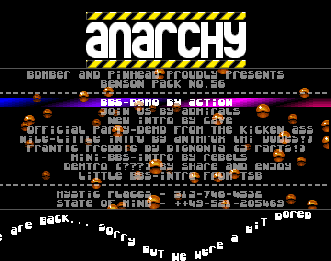
今天国内媒体在讨论芯片音乐的时候,往往在回避演示场景对芯片音乐的贡献和影响而迎合游戏爱好者的怀旧情结,这种描述完全忽视了芯片音乐作为一种地下文化场景反商业化的精神内核,是不够公正客观的。但无论是将芯片音乐与商业化的游戏音乐过度关联,还是围绕“假芯片”的争议,在一定程度上都有其客观原因和历史源流,在下一节课,我们希望追溯千禧年前后至今芯片音乐的发展来回答上面这些问题,并解读90年代中后期LSDJ、Nanoloop等独立演示场景之外的芯片音乐工具及其所带来的“新生代”(new school)音乐场景的特点。
现场问答
Q:MIDI接口传输的是文本格式的数据吗?
A:MIDI并不是一个text-based protocol,虽然相比采样数据而言MIDI数据格式较为工整,在16进制编辑器下较容易被人工解读还原成对应的乐器操作指令,但它并没有采用任何文本编码。
